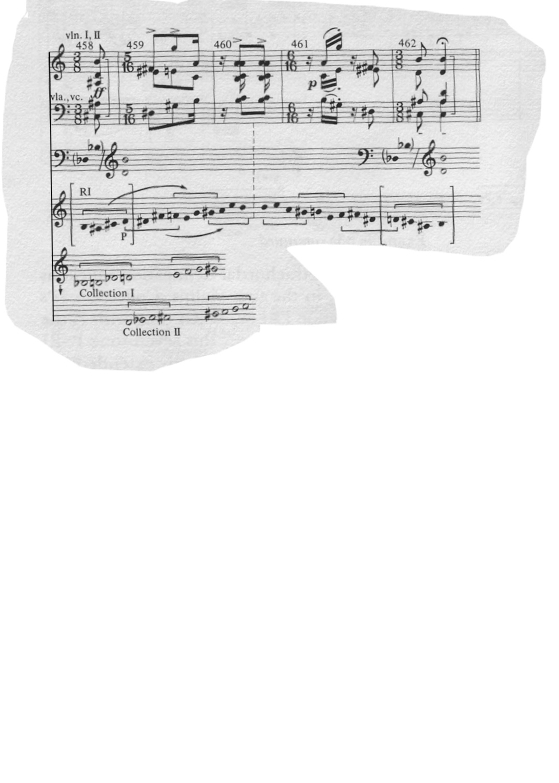[Top][All Lists]
[Date Prev][Date Next][Thread Prev][Thread Next][Date Index][Thread Index]
Re: timing false in one staff only? [with picture]
|
From: |
Damian leGassick |
|
Subject: |
Re: timing false in one staff only? [with picture] |
|
Date: |
Sun, 27 Mar 2011 15:11:13 +0100 |
Thanks David, that's given me some ideas
the example I gave is not the one i'm using - I'm typesetting some bars of
complex Xenakis and showing a pitch-collection below them. Having the Xenakis
in proportional notation, whilst often a good idea, does not work for the bars
in question.
I'm looking for something more like in the attachment, the bottom four staves
are not proportional but they are spaced without regard to the top two. My
workaround at the moment is not to have the staffgroup, use \break and draw
system delimiters by hand (as I did here with this excerpt from a Stravinsky
textbook)
Using the attached example I would also need a pianobrace for staves 1 and 2. I
might then need to attach a further pianostaff below staff 6 and have that 'in
sync' with staves 1 and 2 - and then some 'unsynced' staves below that etc
Damian

On 27 Mar 2011, at 04:06, madMuze wrote:
>
>> thanks for the tip David, but I can't get it to work...
>
> oy, Damian,
>
> sorry for the grief. Note that in your example, it would be \rhyFloat #4
> #4... as there are four eighth notes in the time of four, making this
> command trivial and unnecessary. I've been using this to show unequal
> amounts of time in the same space without disturbing the even setting of the
> running eighth-notes.
>
> To get absolutely even spacing in the bottom staff, you would need:
> \set Score.proportionalNotationDuration = #(ly:make-moment 1 55)
> % or whatever numbers you like for make-moment, along with:
> \override Score.SpacingSpanner #'uniform-stretching = ##t
> (2.12 notation reference, section 4.5.5)
>
> Given that, how do you want the upper voice to be different? To appear with
> the same spacing as though the lower weren't there? Almost certainly, the
> total width of the measure in the upper line would be different than the
> lower. You could, of course, fake it and pad the upper line:
> \rhyFloat #4 #5 { c4 d32[ e32 f16] g8 s8 } % 5 eighths in the time of 4
> or, perhaps:
> \rhyFloat #8 #9 { c4 d32[ e32 f16] g8 s16 } % 9 sixteenths in the time
> of
> 8
> or, if it's just that the 32d notes are crowded:
> \rhyFloat #6 #7 { c4 d32[ s32 e32 s32 f16] } g8 % 7 sixteenths in the
> time
> of 6
> which would have the two parts starting and ending together.
> The lower would be simply:
> c8 d e f
> This routine only works if the total duration of the upper voice is not the
> same as the total duration of the lower, and is likely still more personal
> interference than you may want to do. But, is the result something like you
> are wanting?
> d
>
> --
> View this message in context:
> http://old.nabble.com/timing-false-in-one-staff-only--tp31246377p31247790.html
> Sent from the Gnu - Lilypond - User mailing list archive at Nabble.com.
>
>
> _______________________________________________
> lilypond-user mailing list
> address@hidden
> http://lists.gnu.org/mailman/listinfo/lilypond-user
- timing false in one staff only?, Damian leGassick, 2011/03/26
- Re: timing false in one staff only?, Phil Holmes, 2011/03/26
- Re: timing false in one staff only?, damianlegassick, 2011/03/26
- Re: timing false in one staff only?, madMuze, 2011/03/26
- Re: timing false in one staff only?, damianlegassick, 2011/03/26
- Re: timing false in one staff only?, madMuze, 2011/03/26
- Re: timing false in one staff only? [with picture],
Damian leGassick <=
- Re: timing false in one staff only? [also with picture], madMuze, 2011/03/27
- Re: timing false in one staff only? [also with picture], Damian leGassick, 2011/03/27
- Re: timing false in one staff only? [no longer with picture, just mental flailing], madMuze, 2011/03/27
- RE: timing false in one staff only? [no longer with picture, just mental flailing], James Lowe, 2011/03/28
- Re: timing false in one staff only? [no longer with picture, just mental flailing], Damian leGassick, 2011/03/29